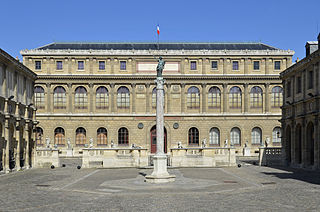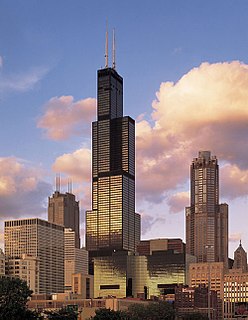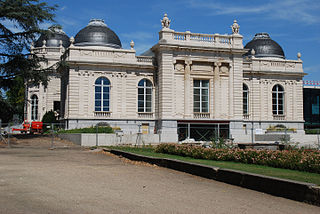
Michael Graves was a noted American architect and designer of consumer products. As well as principal of Michael Graves and Associates and Michael Graves Design Group, he was of a member of The New York Five and the Memphis Group – and professor of architecture at Princeton University for nearly forty years. Following his own partial paralysis in 2003, Graves became an internationally recognized advocate of health care design.

Auguste Perret was a French architect and a pioneer of the architectural use of reinforced concrete. His major works include the Théâtre des Champs-Élysées, the first Art Deco building in Paris; the Church of Notre-Dame du Raincy (1922–23); the Mobilier Nationale in Paris (1937); and the French Economic, Social and Environmental Council building in Paris (1937–39). After World War II he designed a group of buildings in the centre of the port city of Le Havre, including St. Joseph's Church, Le Havre. to replace buildings destroyed by bombing during World War II. His reconstruction of the city is now a World Heritage Site.

Hector Guimard was a French architect and designer, and a prominent figure of the Art Nouveau style. He achieved early fame with his design for the Castel Beranger, the first Art Nouveau apartment building in Paris, which was selected in an 1899 competition as one of the best new building facades in the city. He is best known for the glass and iron edicules or canopies, with ornamental Art Nouveau curves, which he designed to cover the entrances of the first stations of the Paris Metro.

Victor Pierre Horta was a Belgian architect and designer, and one of the founders of the Art Nouveau movement. His Hôtel Tassel in Brussels built in 1892–1893, is often considered the first Art Nouveau house, and, along with three of his other early houses, is listed as a UNESCO World Heritage Site. The curving stylized vegetal forms that Horta used influenced many others, including architect Hector Guimard, who used it in the first house he designed in Paris and in the entrances he designed for the Paris Metro. He is also considered a precursor of modern architecture for his open floor plans and his innovative use of iron, steel and glass.

Beaux-Artsarchitecture was the academic architectural style taught at the École des Beaux-Arts in Paris, particularly from the 1830s to the end of the 19th century. It drew upon the principles of French neoclassicism, but also incorporated Gothic and Renaissance elements, and used modern materials, such as iron and glass. It was an important style in France until the end of the 19th century. It also had a strong influence on architecture in the United States, because of the many prominent American architects who studied at the École des Beaux-Arts, including Henry Hobson Richardson, John Galen Howard, Daniel Burnham, and Louis Sullivan.

The Royal Exhibition Building is a World Heritage-listed building in Melbourne, Victoria, Australia, built in 1879-80 as part of the international exhibition movement, which presented over 50 exhibitions between 1851 and 1915 around the globe. The building sits on approximately 26 hectares, is 150 metres (490 ft) long and is surrounded by four city streets. It is at 9 Nicholson Street in the Carlton Gardens, flanked by Victoria, Carlton and Rathdowne Streets, at the north-eastern edge of the central business district. It was built to host the Melbourne International Exhibition in 1880–81, and then hosted the even larger Centennial International Exhibition in 1888, and the formal opening of the first Parliament of Australia in 1901. The building is representative of the money and pride Victoria had in the 1870s. Throughout the 20th century smaller sections and wings of the building were subject to demolition and fire; however, the main building, known as the Great Hall, survived.

Exhibition Place is a publicly owned mixed-use district in Toronto, Ontario, Canada, located by the shoreline of Lake Ontario, just west of downtown. The 197-acre (80 ha) site includes exhibit, trade, and banquet centres, theatre and music buildings, monuments, parkland, sports facilities, and a number of civic, provincial, and national historic sites. The district's facilities are used year-round for exhibitions, trade shows, public and private functions, and sporting events.

The buildings and architecture of Chicago have influenced and reflected the history of American architecture. The built environment of Chicago is reflective of the city's history and multicultural heritage, featuring prominent buildings in a variety of styles by many important architects. Since most structures within the downtown area were destroyed by the Great Chicago Fire in 1871 Chicago buildings are noted for their originality rather than their antiquity.

Postmodern architecture is a style or movement which emerged in the 1960s as a reaction against the austerity, formality, and lack of variety of modern architecture, particularly in the international style advocated by Philip Johnson and Henry-Russell Hitchcock. The movement was introduced by the architect and urban planner Denise Scott Brown and architectural theorist Robert Venturi in their book Learning from Las Vegas. The style flourished from the 1980s through the 1990s, particularly in the work of Scott Brown & Venturi, Philip Johnson, Charles Moore and Michael Graves. In the late 1990s, it divided into a multitude of new tendencies, including high-tech architecture, neo-futurism and deconstructivism.

The Akron Art Museum is an art museum in Akron, Ohio, United States.

The Musée national des beaux-arts du Québec, often abbreviated as MNBAQ, is an art museum in Quebec City, Quebec, Canada. The museum is situated in Battlefield Park, and is a complex made up of four buildings. Three of the buildings in the complex were purpose-built for the museum, while the other was initially built as a provincial prison, before being re-purposed for museum use.
Baltimore Heritage is an American nonprofit historic-preservation organization headquartered in Baltimore, Maryland.

Moses Chamberlain Edey (1845–1919) was an Ottawa architect who designed the Aberdeen Pavilion at Lansdowne Park, a National Historic Site and the Daly Building (1905–1992), which was Ottawa's first department store.

New Classical architecture, New Classicism or the New Classical movement is a contemporary movement in architecture that continues the practice of Classical architecture. It can be considered as the modern continuation of Neoclassical architecture. The design and construction of buildings in this tradition is continuous throughout the twentieth and twenty-first centuries, even as modernist and other post-classical theories of architecture have been more dominant.
The Monte-Carlo Pavilions, also known as the Pavillons des Merveilles and the Pavillons des Boulingrins, are five temporary commercial buildings in Monaco.

The architecture of Jacksonville is a combination of historic and modern styles reflecting the city's early position as a regional center of business. According to the National Trust for Historic Preservation, there are more buildings built before 1967 in Jacksonville than any other city in Florida, but it is also important to note that few structures in the city center predate the Great Fire of 1901. Numerous buildings in the city have held state height records, dating as far back as 1902, and last holding a record in 1981.
The historical villas of Monaco represent a significant example of residential architecture. Originally seen as symbols of Belle Epoque luxury, they were once emblematic of the Principality itself. However, by the 1950s they were viewed by Monaco's Consultative Committee on Public Works as a social anachronism. While recent years have seen a renewed appreciation within the Principality for villa architecture, the number of historic villas remaining declines each year. In 1954 the Principality possessed 688 villas; only a small fraction of that number still survive.
The Monte-Carlo Sporting, also known as Sporting d'été, is a building complex in Larvotto, Monaco. It includes the Salle des Etoiles, a concert hall, and it is the main venue for society fundraisers in Monaco.

The Palais des Beaux-Arts de Liège is a building at the centre of the Parc de la Boverie in the Belgian city of Liège. It was designed by Charles Étienne Soubre and Jean-Laurent Hasse and is the only building constructed for the Liège International in 1905 which was not demolished at the end of the event. The event's organising committee left it to the city and it became the 'Palais des Fêtes et des Expositions', hosting conferences, balls, banquets, salons and major exhibitions such as the exhibition on the COBRA movement in 1951.
Arthur Justin Drexler was a museum curator and director of the Museum of Modern Art (MoMA) for 35 years.















